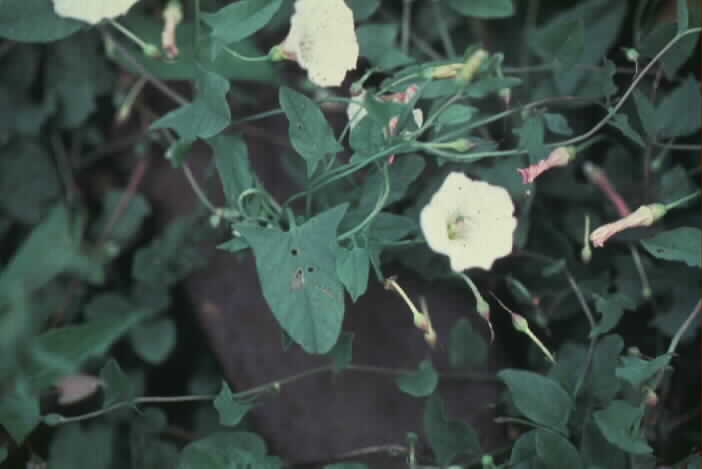Field Bindweed Control Program

DESCRIPTION
Field bindweed, a perennial, reproduces by seeds and rootstocks. The root system is extensive, extending to a depth of 20 to 30 feet. The smooth, slender stems twine or spread over the soil and vegetation. Leaves up to 2 inches long are alternate, simple, petioled, quite variable in size, and highly variable in shape. The leaf blade may be oblong to elliptical or may be rounded to pointed with spreading basal lobes. Flowers are white, pink, or white with pink. Funnel shaped, they are about 1 inch across and usually borne singly in the axils of leaves. The flower stalk has two bracts ½ to 2 inches below the flower; the bracts, along with leaf shape and small flower size distinguish this plant from hedge bindweed. Seeds are dark, brownish-gray, about 1/8 inch long, and have one rounded and two flattened sides.
HOW TO REDUCE NEW BINDWEED INFESTATIONS
Field bindweed is spread both by seed and by roots. New field bindweed infestations result from planting crop seed with bindweed seed or from portions of bindweed roots transported by tillage machinery. Harvesting equipment, manure from livestock fed
contaminated feed, and grazing animals moved from infested to clean areas also cause new bindweed infestations. Seed is carried by birds, on feet of animals, or on wheels of machinery; and seeds or plant parts can be spread by road machinery. Bindweed seed is also carried in drainage water.
Small grain, forage, and legume seed should be cleaned before planting to remove seed of bindweed and other weeds. For livestock feed, one should use grain, hay, and other foodstuffs not infested with bindweed or other weeds difficult to control. If bindweed infested feed is fed to live-stock the manure should not be spread on bindweed free land. Harvesting, tillage, and other machinery should be cleaned before it leaves a bindweed infested field.
CONTROL PRACTICES
Control of field bindweed shall mean preventing the production of viable seed and destroying the plant’s ability to reproduce by vegetative means.
Bindweed seed is viable after remaining dormant in the soil for many years. Seed brought near the soil surface by tillage, rodents, or other means will germinate under favorable conditions, resulting in new bindweed infestations.
Effective field bindweed control can be achieved by applying appropriate control practices. In developing a bindweed control program, one should consider the various alternate control practices and use one or more appropriate control practices for a particular cropland or non-cropland area.
CONTROL PRACTICES FOR CROPLAND
Practices approved for controlling bindweed are: (1) Plant competitive crops, (2) Appropriate and timely cultivation, and (3) application of herbicides registered for use in infested crops or on crop land with no growing crop. Often a combination of control practices results in a more effective program than does a single practice.
Competitive cropping - Close drilled sorghum or Sudan grass seeded about July 1, after a period of intensive cultivation,
provides effective competition for field bindweed. Narrow row grain sorghum may also be used. The effectiveness of all competitive crops depends on intensive cultivation during the bindweed growing season when land is not in crop.
Appropriate and timely cultivation - Intensive cultivation, if properly used, is effective in killing established bindweed. Intensive cultivation alone, however, is not usually practical because no crops can be grown during the cultivation period. Cultivation used with competitive crops can control bindweed. With small grains, the most favorable times for beginning cultivation are in the spring after bindweed growth has started, or in the fall after the grain has been harvested. The depth for cultivation in medium heavy soil is 4 inches. Bindweed cannot be controlled satisfactorily if cultivation is delayed as long as 20 or 28 days after bindweed emergence.
CONTROL PRACTICES FOR NONCROPLAND
Practices approved for controlling bindweed on non-cropland are: (1) hoeing and (2) application of appropriate herbicides.
Hoeing - In non-cropland areas such as home gardens and flower beds and for horticultural or forestry plants, thorough hoeing every 10 days to 2 weeks during the growing season can control bindweed effectively.
It is essential to cut off all plants at each hoeing. Bindweed plants missed in hoeing replenish their reserves, which delays killing time. Results will not be satisfactory if bindweed plants are left outside the hoed area because those plants will supply food to the roots for a distance of about 10 feet, preventing the killing of established bindweed in the hoed area.
HERBICIDES APPROVED FOR CONTROLLING FIELD BINDWEED
The following herbicides may be used for cost-share with landowners. Others labeled for bindweed may be used but not cost-shared. Always follow label instructions and precautions.
2-4-D Amine or LV Ester. Apply during active growth in spring when plant is in bud stage or in fall after 12 inches of new growth.
Clarity (Dicamba). After crop harvest, apply as spot treatment to stubble, fallow or other cropland. Apply during bindweed growth but before killing frost.
Clarity + 2-4-D
Roundup (Glyphosate) Sold for bindweed control during August, September, and October.
Tordon 22k (Picloram) A restricted use herbicide. Use caution if planting a broadleaf crop in the future.
Tordon 22k + 2-4D A restricted use herbicide. Use caution if planting a broadleaf crop in the future.
BIOLOGICAL CONTROL PRACTICES
There are no biological controls approved for field bindweed at this time.




